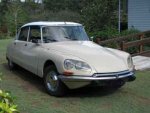Hi Syd,
Well if you can avoid the time from 6:30am to 9:30 am and 4:30 pm to 6:30 pm Mon to Fri plus 10 am to 3 pm Sat anywhere within 15km of the melb cbd, then go for it!
During those times I think that Melbourne traffic is the worst in Australia and the inner east and south east suburbs that I struggle through are choked during those periods and full of aggresive frustrated drivers, plus the same around school times in the afternoon around 3pmish. I only have manual cars (only owned one auto for 5 years in 40 years of motoring) so changing gear is in my DNA but the column change and heavy clutch on the ID is not condusive to stop/start/creep along traffic.
For drives to Geelong, Castlemaine and the like, perfect! But you have to understand them thoroughly to be able to cope when something goes wrong because you won't get meaningful help "out there" (referring to the hydraulics and brakes here) - at least not quickly.
Plus if you are relying on it as your only car (did I pick that up somewhere?) then you may well spend considerable time with the car off the road when you need parts, because most parts have to come from Europe with associated delays and expense. Just need to reconcile yourself to these things (if indeed this would be your primary car).
Regards
leconte
Well if you can avoid the time from 6:30am to 9:30 am and 4:30 pm to 6:30 pm Mon to Fri plus 10 am to 3 pm Sat anywhere within 15km of the melb cbd, then go for it!
During those times I think that Melbourne traffic is the worst in Australia and the inner east and south east suburbs that I struggle through are choked during those periods and full of aggresive frustrated drivers, plus the same around school times in the afternoon around 3pmish. I only have manual cars (only owned one auto for 5 years in 40 years of motoring) so changing gear is in my DNA but the column change and heavy clutch on the ID is not condusive to stop/start/creep along traffic.
For drives to Geelong, Castlemaine and the like, perfect! But you have to understand them thoroughly to be able to cope when something goes wrong because you won't get meaningful help "out there" (referring to the hydraulics and brakes here) - at least not quickly.
Plus if you are relying on it as your only car (did I pick that up somewhere?) then you may well spend considerable time with the car off the road when you need parts, because most parts have to come from Europe with associated delays and expense. Just need to reconcile yourself to these things (if indeed this would be your primary car).
Regards
leconte
Last edited:

